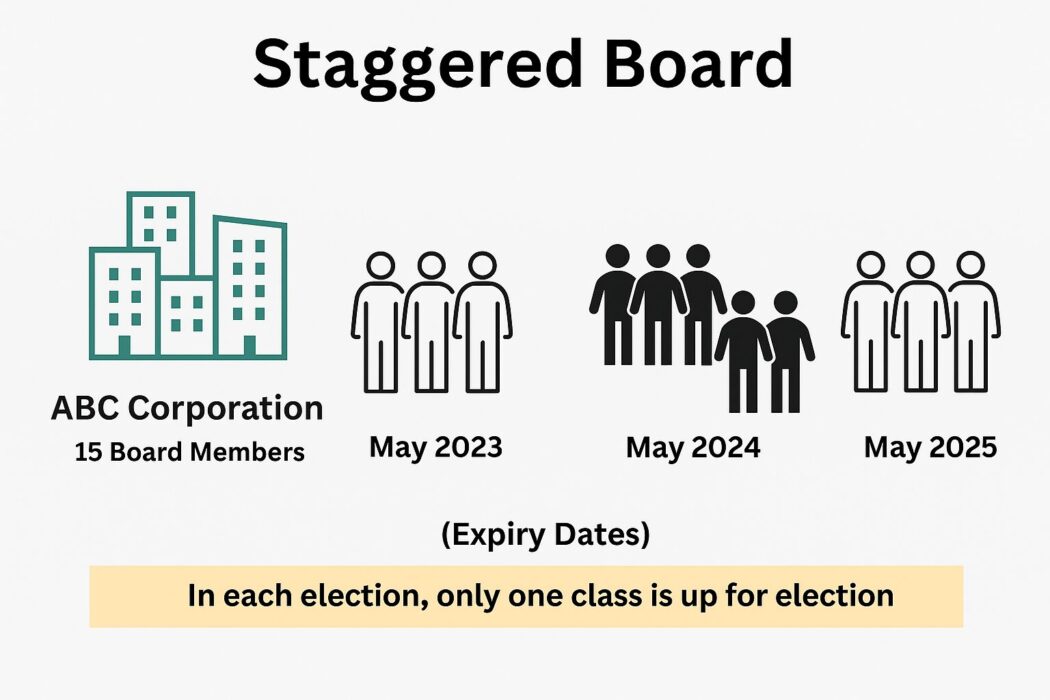A staggered board, also called a classified board, is a form of corporate governance that companies may adopt. The objective behind this strategy is to ensure the stability and continuity of leadership within the company. This provision determines how board members are appointed and their tenure.
Founders who desire to include a staggered board structure must integrate it into the company’s certificate of incorporation. Alternatively, they can include it in the initial bylaws. Or, in the bylaws that the shareholders adopt, as permitted by the Delaware General Corporation Law
The primary advantage of having a staggered board structure is that it deters hostile takeovers from gaining control of the company. On the flip side, it can reduce shareholder influence and entrench management. Read ahead to understand how this governance works and its pros and cons.

*FREE DOWNLOAD*
The Ultimate Guide To Pitch Decks
Understanding What a Staggered Board Is
Companies adopt different practices for structuring their board of directors so they can achieve their core objectives and mission statement. Selecting the optimal structure is crucial, as the board plays a pivotal role in shaping the company’s growth trajectory.
A staggered board splits the directors into various classes, with each class serving multiple-year terms. Director elections typically occur once a year at the annual meeting. Thanks to this structure, the board remains independent of external influence and can lead the company toward profitability.
Even if activist shareholders, third parties, or hostile bidders take over the company, it can continue to operate independently of their influence. Typically, companies have three to five classes, and only one class is up for election at a given time.
Let’s try an example. A company has five classes of directors, namely, A, B, C, D, and E. Class A has a one-year term, while Classes B and C have two- and three-year terms, respectively. Then again, Class D has a four-year term, and Class E enjoys an eight-year term.
The company thus holds elections for Class A every year. However, a new set of directors assumes office for Class B every other year. As a result, any hostile takeover bids may have to wait for years before they can get board seats. And, consequently, control over the company’s decision-making.
A third party seeking to execute a hostile takeover must hold an adequate number of board seats. And a staggered board makes the move highly challenging. In this way, a classified board has a higher chance of averting a takeover than a conventional board.
For-profit and non-profit organizations opt for this structure since it enables streamlined succession planning. Thus, they are also better positioned to implement the right strategies to ensure long-term profits and scalability.

Raise Capital Smarter, Not Harder
- AI Investor Matching: Get instantly connected with the right investors
- Pitch & Financial Model Tools: Sharpen your story with battle-tested frameworks
- Proven Results: Founders are closing 3× faster using StartupFundraising.com
Electing a Board of Directors
A conventional board comprises members that shareholders elect into office for a 12-month tenure. Shareholders appoint directors during the annual meeting, but they also have the option to vote them out of office. That is, if the shareholders are dissatisfied with the company’s performance.
As a result, these voters retain complete influence over the decision-making process. At each annual meeting, shareholders evaluate and appoint board members, as well as determine their salary structure. These directors are responsible for providing strategic leadership for the company.
They have a fiduciary responsibility to represent and act in the best interests of and to protect and uphold shareholders’ interests. Board members must monitor and evaluate the company’s metrics and performance to assess the impact of their decisions. They must also consider the potential risks and devise risk-mitigation strategies.
When shareholders appoint directors, they may also assign specific roles and responsibilities to each. Similarly, when appointing a staggered board, they can assign roles and responsibilities to a class for a specific term only.
Structuring a Staggered Board
The staggered structure can apply to tenures or roles as per the company’s bylaws. Some directors may have longer terms than others, with specific roles assigned during that tenure. Once the terms expire, the shareholders organize fresh elections at the annual meetings to appoint new directors.
Since not all tenures expire at the same time, different classes could have overlapping multi-year terms. For instance, in case the company has a three-class staggered board, a third of the directors serve a three-year term. During each annual election, a third of the directors are appointed.
Though, it is not unusual for shareholders to appoint senior and more experienced directors for longer terms. They may designate certain directors to hold positions for extended terms to perform specific, pre-determined actions. And, take on certain responsibilities.
These directors can thus focus on long-term growth instead of delivering short-term results. At the same time, the board consistently features fresh faces and new talent in managing the company’s operations. Maintaining continuity is another advantage.
The company is more risk-resistant because it avoids a complete change in management. For instance, during economic downturns and changing geopolitical conditions, strong leadership can steer it toward sustaining setbacks.
Appointing directors, their terms, and their roles depend on the company’s needs and its performance under their leadership. When shareholders convene for annual meetings, they must elect directors to posts that are now vacant. Ultimately, it is up to shareholders to vote and elect new board members.

Integrating Board Succession Planning
Board succession planning is an extension of the staggered board structure. In this case, founders execute a proactive process in which they identify individuals who can replace existing board members. These individuals are carefully selected based on their qualifications and experience.
The objective here is to have board candidates on standby in the event that directors retire or their terms end. These candidates can also assume the board seat if it becomes vacant unexpectedly. Succession planning ensures that the leadership transitions smoothly and the company is stable.
The new board candidate has the right skills and a diverse background, enabling them to step into the role quickly. A successive board secures the company against instability and loss of direction in the event of leadership changes. It is typically used when board seats have only a one-year tenure.
Veteran directors who have been in the company for an extended time supervise candidates as they receive training. The mentoring they provide prepares the candidates for their future roles. In this way, having a successive board is an excellent risk mitigation strategy.
Advantages of a Staggered Board
As mentioned earlier, the company’s founders can choose the staggered board structure at the time of its incorporation. This decision is typically driven by a forward-thinking perspective and the intent to avert hostile takeovers. Several other advantages can result from adopting a staggered board.
- Having a staggered board can make it virtually impossible for third parties to execute a hostile takeover. They must wait for more than a year to gain control of the board across several director classes. Sometimes, they may have to wait longer to elect their preferred directors to a specific class.
- The time frame for electing directors gives the company’s founders and owners time to undertake the necessary steps to prevent takeovers.
- Since directors expect longer tenures, they are better positioned to make strategic decisions that contribute to the company’s long-term performance. They are motivated to work harder and deliver results within their tenure and beyond, but without worrying about re-elections.
- The company will always have seasoned directors on board who understand its operations and can steer it forward. This continuity in leadership can be crucial for success.
- The logistics of onboarding, training, and orienting incoming directors are more streamlined since senior directors are monitoring the process. Their mentoring can prove invaluable for new talent.
- A staggered board ensures that not all directors leave their positions simultaneously. This smoothens succession planning for the founders.
- Activist investors attempting a takeover can often destabilize the company because of the sudden and unexpected change in management. Classified board structures can secure the company’s long-term stability and success.
- If the company is performing well, it makes sense to retain the current board of directors.
Downsides of a Staggered Board
The biggest downside of a staggered board is the impact on shareholder interests. As in the case of a conventional board, directors have a one-year tenure. After this term expires, shareholders appoint an entirely new board during the annual meeting.
They can base their decisions on performance, merit, and the company’s results. However, staggered boards assign directors with extended terms, which may be three years or more, depending on the structure. Experts argue that this policy can lead to director entrenchment.
Members of the board may disregard shareholder interests, knowing that they cannot be removed soon. This can negatively impact the company’s performance due to a lack of accountability. Directors who are underperforming and unfit for their roles will retain their board seats longer.
Research indicates that companies with staggered boards typically exhibit lower shareholder returns and, consequently, have lower valuations. This can impact the company’s ability to raise funding and may come under scrutiny from proxy advisory firms.
Investors usually retain the services of such firms that provide research, analysis, and investment recommendations. A poor review can spell disaster for the company.
Keep in mind that storytelling is everything in fundraising. In this regard, for a winning pitch deck to help you here, take a look at the template created by Peter Thiel, the Silicon Valley legend (see it here) that I recently covered. Thiel was the first angel investor in Facebook with a $500K check that turned into more than $1 billion in cash.
Remember to unlock the pitch deck template that founders worldwide are using to raise millions below.
Leveraging a Staggered Board as a Poison Pill Strategy
As explained earlier, a staggered board can be an effective “poison pill” strategy to avert a potential hostile takeover. Here’s how.
- Scenario 1: Company A has a conventional board with 12 directors. At the next annual general meeting, a third party elects 7 or 8 directors of their choice to the board. Now that they have a board majority in the company, they can influence decisions and take over. The new directors can also split it and liquidate its assets.
- Scenario 2: Company A has a staggered board with 12 directors, with each having a three-year tenure. At the next annual general meeting, a third party elects 2 preferred directors out of the 4 up for selection. As a result, they have a board minority. The hostile party must wait for at least two years before it can elect an adequate number of preferred directors. Meanwhile, the founder/owner can take the necessary action to prevent the takeover entirely.
Is Having a Staggered Board Advisable?
In recent years, several arguments have arisen regarding the feasibility of having a staggered board. Is this strategy suitable for your company? Studies indicate that in recent years, approximately 74% of S&P 1500 companies and 88% of S&P 500 companies have preferred to hold annual elections.
Detractors point to lowered shareholder returns, which goes against their interests. When it comes to raising funding, institutional investors may hesitate to invest in a company with a staggered board.
Aside from red flags that proxy advisory firms may raise, investors consider the lack of accountability arising from director entrenchment to be a downside. Thus, the company may face issues with raising equity, electing directors, and navigating governance-related proposals.
If you’re approaching a venture capital (VC) fund or private equity (PE) fund, the concerns may be different. These investors typically require board seats and voting rights to influence decision-making. They may structure the term sheet to account for the staggered board framework.
However, if you’re raising debt financing, creditors may not be concerned about the composition of the board. You’ll demonstrate adequate cash flows and offer them risk-mitigating covenants to secure capital.
The bottom line is that having a staggered board does not directly influence a company’s ability to raise capital. However, founders should prepare to offer higher interest rates and more attractive terms and conditions. Investors may require some form of compensation for governance risk.
Before adopting the staggered board structure, you’ll consider several factors, and shareholder and investor interests are only the beginning. For instance, you’ll weigh how the company can benefit from a balance of fresh talent and seasoned leadership.
Additionally, calculate the costs associated with hiring and onboarding new directors on a periodic basis. Most importantly, evaluate the risks that the company faces in the event of a hostile takeover.
Now that you have an overview of how to elect directors, check out this video in which I have explained what to expect from board members. You’ll find it helpful when assigning the rights roles and responsibilities to each.
The Takeaway!
The decision of whether to have a staggered board governance structure requires careful thought. You’ll weigh the pros and cons and select the option that is best aligned with your new company and its needs. Discuss the issue with your startup consultant, who will guide you in the right direction.
You may also find our free library of business templates interesting. There, you will find every single template you need to build and scale your business completely, all for free. See it here.





Facebook Comments